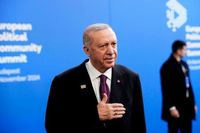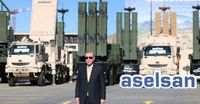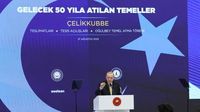On August 27, 2025, Turkish President Recep Tayyip Erdogan stood before a crowd at the Ankara headquarters of Aselsan, the country’s leading defense contractor, to unveil what he called a “watershed moment” for Turkey’s military ambitions: the Steel Dome integrated air defense system. The ceremony was more than a ribbon-cutting—it marked a turning point in Turkey’s quest for defense self-sufficiency and global influence.
“These systems are a show of strength for Turkey,” Erdogan declared, his words echoing through the newly inaugurated production facilities. “In air defense, we are ushering in a new era for our beloved Turkey.” According to Associated Press and Kursiv Uzbekistan, the Steel Dome is designed to link sea- and land-based platforms and sensors into a seamless network, aimed at shielding Turkish airspace from an ever-evolving array of threats. The first batch delivered includes 47 vehicles valued at $460 million, a significant investment for a nation determined to stand on its own two feet in the realm of defense.
The Steel Dome’s unveiling comes at a time when regional security challenges are mounting. Ongoing conflicts in Syria and Ukraine, as well as recent Israeli strikes on Iran, have underscored the vulnerabilities of national airspace—even for countries with robust militaries. Erdogan didn’t mince words about the stakes. “No country that cannot develop its own radar and air defense system can look to its future with confidence in the face of current security challenges, especially in our region,” he said, as reported by AP and Kursiv Uzbekistan.
The system itself is a technological leap. As detailed by Ainvest, the Steel Dome is modular and AI-assisted, incorporating short-range Korkut and Gürz systems, medium-range Hisar missiles, and long-range Siper interceptors. It’s all tied together by the HAKİM command-and-control system and space-based sensors via T-link communication, allowing for real-time threat detection and rapid response. This layered approach means Turkey can counter not just conventional aircraft, but also drones, hypersonic missiles, and asymmetric threats—an essential capability in today’s unpredictable security landscape.
Crucially, the Steel Dome’s design is adaptable. Unlike the U.S. Patriot or Russian S-400 systems, which tend to be rigid and closely linked to their countries’ political interests, Turkey’s system can be tailored for export to a variety of markets, from Gulf states to Eastern Europe. Aselsan CEO Ahmet Akyol highlighted this flexibility, noting the system’s interoperability with Turkish naval platforms like the TF-2000 destroyers. “Others have started working on this after us, which proves how right our path is,” Akyol said at the ceremony, according to Daily Sabah. He added, “This architecture will make a difference in the world.”
Turkey’s journey to this point hasn’t been without setbacks. In 2019, Ankara’s decision to purchase Russian S-400 missile systems led to its exclusion from the U.S.-led F-35 fighter jet program—a blow to its aspirations for cutting-edge air power. But rather than retreat, Turkish officials doubled down on domestic innovation. As Erdogan put it, “In the next 50 years, Turkey will be a country that not only meets its own needs but also leads the world with its technology.”
That ambition is evident in Aselsan’s recent expansion. The company has just laid the foundation for what will be Europe’s largest air defense facility, spanning a massive 6,500 acres. Fourteen new production sites have been inaugurated, increasing Aselsan’s manufacturing capacity by 40%. The new R&D hub, launched this August with a $1.5 billion investment, is set to accelerate the development of next-generation technologies, including AI-driven command systems, precision-guided munitions, and even directed-energy weapons.
The numbers tell a story of momentum. In the first half of 2025, Aselsan reported inflation-adjusted revenue of $1.32 billion—a robust 11.3% year-on-year increase—according to Ainvest. Export contracts have surged to $2.8 billion, and the company boasts a $16 billion order backlog. Operating EBITDA reached $3.37 billion, maintaining a healthy 25% margin, while R&D investments jumped 42% to $572 million. Turkey’s defense exports hit $7.1 billion this year, with projections aiming as high as $8 billion by December.
But why does all this matter on the world stage? The global arms market is more fractured than ever, as traditional suppliers like the U.S., Russia, and China face political constraints and shifting alliances. Turkey, straddling Europe and the Middle East, is positioning itself as a bridge—offering advanced, customizable systems to countries keen to avoid the strings often attached to Western or Russian hardware. The Steel Dome’s modular architecture and AI integration make it particularly attractive to nations seeking flexible, independent defense solutions.
This strategy isn’t just about pride or profit. It’s rooted in history. Ever since the U.S. imposed an arms embargo on Turkey following its 1974 intervention in Cyprus, the country has been determined to reduce its reliance on foreign suppliers. That drive for self-sufficiency has only grown as geopolitical tensions have flared. Aselsan’s CEO Akyol summed it up: “By moving to the dome—the next level of integrated air defense—ASELSAN has become an important global player.”
Of course, challenges remain. Turkey’s procurement of the S-400 system strained its relations with NATO and resulted in sanctions. Internal political dynamics, such as the politicization of military appointments, have raised concerns about institutional stability. Yet, as Ainvest points out, these hurdles have only reinforced the country’s commitment to self-reliance. The Steel Dome’s compatibility with NATO platforms, via the HERİKKS early warning system, allows Turkey to keep one foot in the alliance even as it blazes its own path.
For investors and defense analysts, the Steel Dome represents a calculated risk—but also a significant opportunity. Aselsan’s financial discipline, R&D momentum, and alignment with Turkey’s broader industrial strategy create a strong foundation for growth. If projections hold, Aselsan could break into the global top 30 defense firms by 2030, powered by the export potential of the Steel Dome and joint production deals in key markets.
As the ceremony drew to a close, Erdogan’s message was clear: Turkey is betting on itself. The Steel Dome is more than a defense system—it’s a symbol of national ambition, technological prowess, and a new era of strategic independence. Whether this bold gamble pays off on the world stage remains to be seen, but for now, Turkey’s skies—and its defense industry—have never looked more secure.



